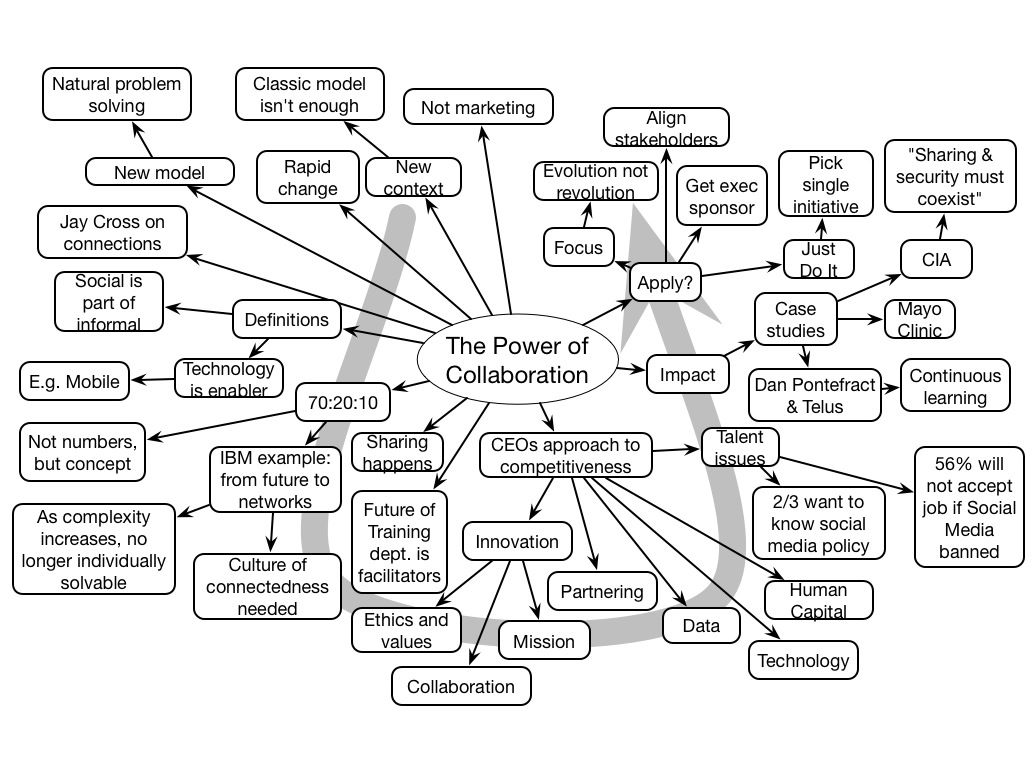The legendary Steve “The Woz” Wozniak was the opening keynote at the 3rd International Conference of e-Learning and Distance Learning. In a wide-ranging, engaging, and personal speech, Steve made a powerful plea for the value of the thoughtful learner and intrinsic motivation, project-based learning, social, and self-paced learning.
Real mLearning
Too many times, at conference expos and advertisements, it appears that folks are trying to say that courses on a tablet (or phone) are mlearning. On the contrary, I’ll suggest that courses on a phone or a tablet are elearning. Then, what is mlearning?
My argument is pretty simple: just because courses are on a different device, if they’re a traditional course – page turning with knowledge test, a virtual classroom, or even a simulation – if it’s only made touch-enabled, it’s still just elearning. Even if you strip it down to work on a phone, minimizing text, how is it really, qualitatively different?
Now, if you start breaking it up into chunks, and distributing it over time, we’re in a bit of a grey area, but really, isn’t that just what we should be doing in elearning, too? Learning needs to be distributed, but this is still just a greater degree of convenience than doing the same on a laptop. It’s a quantitative shift, not tapping into the inherent nature of mobile.
So, when is it really mlearning? I want to suggest that mlearning – and here I’m talking about courses, not mobile performance support, mobile social, etc, which also could and should be considered mlearning or at least mperformance – is when you’re using the local context to support learning. That could be restated as when you are turning a performance situation into a learning situation, wrapping the performance context with resources and support to take a performance experience and turn it into a learning experience.
Most of our formal learning involves what IBM termed ‘work-apart’ learning, something that happens away from your regular job. And most training and online learning are just that, separated from work. We artificially create contexts that mimic the workplace in most of our learning. And there are occasionally good reasons to do that, like handling multiple people and when failure can be costly or expensive.
Now, however, when we can bring digital technology wherever we are, we can use our real work to be the base of the learning experience. We don’t need an external context, we’re in one! We can provide concepts, examples, and feedback around real contextualized practice. Or, we can add a layer to performance support that educates, not just supports, as Gloria Gery had proposed (but is still to be seen).
And, if the work context is using the desktop, then mobile isn’t necessarily a sensible solution. However, on those increasing circumstances when we’re on a site visit, meeting, at an event, and generally away from our desks, mlearning as I’m construing it here makes sense.
I don’t want to discount the value of elearning on mobile devices, particularly on tablets (where I have argued that the intimacy may have uniquely beneficial impacts), but I do think we shouldn’t consider context-free courses on a small device as anything other than just elearning. So, the question I’m wrestling with is whether mlearning includes mobile performance support, informal, etc, or do we want a separate term for that? But I kinda do want to keep mlearning from not meaning ‘courses on a phone (or tablet)’. What say you?
Living with Complexity
Don Norman (disclaimer, my PhD advisor and mentor) has had a string of important books, starting with his stellar Design of Everyday Things (tops my ‘recommended books’ list for designers). His latest, Living with Complexity, is not as landmark a book as that, but it has some very astute thinking to present.
The book, as the title implies, is largely about how complexity isn’t bad, it’s necessary, and the real issue is about designing to manage it. We want powerful systems to accomplish meaningful goals, and he makes the case that this naturally requires complexity, either at the front end or at the back end. Complexity at the front end offers powerful choice at the tradeoff of comprehensibility, which we often want. Complexity at the back end can seem like magic, but offers more opportunity for things to go wrong catastrophically.
Good design is naturally the solution. He suggests that good design makes complexity usable, and bad design makes complexity frustrating. And he makes a strong point that it’s now about services.
He goes beyond product design in detailing how you really aren’t designing just a product, but an experience, and that it takes a system to create an experience. Using Apple’s iPod, he points out how simplifying the purchasing (backend: lining up publishers to allow downloading individual titles for a simple fee) and downloading music (instead of converting files and storing in special folders) made a device that could carry a lot of music in a small package.
He goes deeper into service design, using the examples of waiting in lines (I now know why immigration in SFO can be so frustrating!). He finally gets to coverage of recommendations for improvements, including signifying (making affordances perceivable), checklists, and job aids (over courses). His focus is on tapping into how our minds work, and aligning tools with them. He covers both sides, including what designers should do differently, and what ‘consumers’ can do. He also covers some of the mismatches between design and consumers, going beyond the design to the overall system.
Overall, while seemingly not as well structured as previous books, this book offers some advanced thinking into design that will benefit those looking to take a bigger picture. Feeling more like a collection rather than a coherent narrative, each of the elements is related and there are important insights in each section. Recommended for the advanced designer.
Engagement, people!
I’m working on a project with a partner, and have this really sharp ID working with me. My role is to be guiding the design, not doing it, and it’s working well. The thing I see, however, is emblematic of what I’m seeing much more broadly: the dissociation between the designer and the learning experience.
Ok, so not many ID theorists are talking about the emotional engagement. Keller and his ARCS model is really the only one. And some folks are touting it for elearning. Michael Allen and his mantra of “no more boring elearning” has been at the forefront for a long time. Julie Dirksen covers it in her recent book, and it’s also implicit in Cathy Moore’s Action Mapping & Roger Schank’s Goal-Based Scenarios. Yet somehow the message isn’t getting through.
The output, however, is at arm’s distance from the learner. It’s got comprehensive coverage. It’s got stories, and animations (I’m having some effect :), but they’re so abstract. So overwritten. So impersonal. It’s not the ID’s fault. Where, in most programs in ID, in most settings, do you see a focus on learner experience? Not clicky-clicky bling bling, as Cammy Bean so aptly coined it, but really engaging learning. It’s harder to find than you think.
There are several important components:
Making it meaningful: focus on changes that will impact the workplace and help convey to the learner that this is real and really needed. If it’s not tied to impacting a business metric, it’s probably not the right topic.
Making it personal: this includes several things. One is writing like you’re talking to the person. Another is having them connect it to their own practices, either retroactively or proactively. Give them an assignment about what to do in the workplace that they bring back.
Making it visceral: this means introducing and using examples that go beneath the merely informative, and tap into basic instincts. Learners should be connected in a very emotional way, using fear or empathy or other hook that appeals directly to their personal needs in ways that cause them to resonate in their core.
Minimalizing: going through and slashing your verbiage. Most elearning is grossly overwritten, and can be trimmed at least 40%, and usually can be trimmed down 60% or more. You want to use rich media (I’m pushing graphic novel formats in the project) and animations, but much less prose and production than you think you need.
Putting it into practice: this means having the learner perform the way they’ll need to perform outside the learning experience. Get them making the decisions in practice that you want in the workplace. It’s not about knowing, it’s about doing. Until they can’t get it wrong.
Making it flow: think about not just the individual bits, but also the segue between them. What’s the emotional trajectory the learner goes through? How are they intrigued, and how do we lead them from apathy and anxiety to motivation and confidence?
These are the top level categories, but they map out into more practices. And you should be working on these in your teams. And I can state from experience that just workshops by themselves aren’t sufficient, and what really helps are an exposure to the principles and the practice, then feedback on a series of attempts until satisfied that the principles have been internalized in the practice. Please, go beyond content, and get into real experience design. Systematically, reliably, and repeatedly. For your learners, and for the industry. We need to lift our game.
Old -> New
My ITA Colleague Jay Cross had a hangout over the weekend and the conversation rolled around to the role of L&D in the new era (related to yesterday’s post). I’ve previously addressed how we can now be using tech for more of the full suite of performance, but it occurred to me that there are some ways we could and should be thinking differently about the ways in which performance can be supported. And while these old:new lists are fun and sometimes overdone, and these may have been covered elsewhere by others, it seemed reasonable to go through a few that occurred to me.
Courses -> Search
The first is that too often we think of courses, but what’s happening these days is that people are increasingly self-helping. Rather than take a course ‘just in case’, they’re getting the help they need ‘just in time’. It seems to me that we should be focusing on making sure that learners have good search skills, and searchable and well-organized portals, to ensure searching success. Whether you view it as performance support or a ‘teachable’ moment, the fact is that learners are self-serving, going for pull solutions more. The goal is to support performers how they want to, and are learning, rather than trying to force them into our models.
Instruction -> Coaching
As social media is more available, people are more available, and people are often reaching out to others for support rather than courses. Whether it’s a quick query through a microblog or a full blown video chat, people are increasingly reaching out to folks for help. This is similar to the courses/search above, but sometimes they go for content and sometimes for people. Are you making it easy to reach out to people?
Development -> Mentoring
Rather than developing people through programs, increasingly people are looking for mentoring. Programmed development is like taking the bus, when mentoring is like having a chauffeur. It may seem extravagant, but folks like to help, and increasingly having a program of ‘each one teach one’, where those who’ve benefitted from mentoring pass it on, is workable. With digital support, this becomes both a more momentary, and longer term activity. It’s increasingly viable, so it should be on your radar.
Read -> Watch
It used to be that to the only way to find things out was to read the manual, or a step-by-step job aid. That’s no longer true, and increasingly it’s easy to create videos that show how to do things. So, for example, it’s now easy to create software ‘walkthrus’, and it’s not just the L&D department that are creating them. Learners are getting them through services like Lynda.com, and creating their own with screen casting software. Not to say reading won’t continue to play a role for concepts, but for procedures, the context and dynamism makes videos powerful. Are you supporting video/screen cast creation, hosting, and searching?
Test -> Simulation
The pragmatic barriers to creating simulations are falling down, and we now know that knowledge test isn’t an adequate assessment of ability to apply. We no longer have to have separate summative assessments, as digital environments can store performance as part of a portfolio of ability. Most importantly, we can make the practice environment much closer to the performance environment. When we’ve determined a real skill needs to be developed, we can and should be looking at rich assessments of ability.
“’til they get it right” -> “’til they can’t get it wrong”
Coupled with the above is the notion that we can move from minimal practice that isn’t sufficient to develop capability and confidence, and start providing sufficient practice to ensure ability. We need to be spacing it out over time, and ensuring real competence, not just until folks have had a taste of it, but inadequate to develop real capability. If it matters, we need to match practice to task and learner, and we can.
Desktop -> Mobile
People are now going ‘mobile first’, as are companies like Google. The reality is that the mobile devices are more familiar, and more available. People are getting in the habit of getting their support through a mobile device. And enterprise platforms are increasingly making that solution available. Are you enabling your workers to meet their needs with mobile?
These are just a few ways we can, and should, be shifting our thinking. I’m sure you’ve got more, and I look forward to hearing them.
#itashare
Starting from scratch
From a conversation with my ITA colleagues, talking about the (self-imposed) death of L&D that Charles wrote about, Jane wondered what we might do if we were starting from scratch. I decided to take this on, thinking about an org that was already in operation, with it’s goals, processes, and practices, and what I might do if I were to come in and get it going (with the support of the executive team to do what I thought was right).
My initial step would be to establish a social media system, supporting conversations and collaboration on work teams and communities of practice. I’d make sure that folks could establish dialogs, work together on documents, and share files, quick pointers, and more fully developed thoughts. They’d also be able to both create and share media, video, audio, and screencasts. I’d want to have some folks supporting the development of the use of this capability, in a performance consulting or performance strategist role.
Associated with this would be a big emphasis on transparency in communication, with the overall mission of the org percolating all the way through, and emphasizing the part each role plays in the overall picture. Another emphasis would be on developing individual capability for self-learning.
My second step would be to set up a mechanism to support portals organized around work tasks (not by org silo), where media, files, and conversations around topics could happen. The goal is to have tools ‘to hand’ as well as people. Thus, any created job aids would be appropriately located. Again, with a performance strategy focus. This is related to the first point.
Finally, I’d consider formal learning to supplement the informal learning, in places where it demonstrably would add value, with a view to minimizing the use of this except where a sound business case could be made that the time spent was aligned to key business indicator, and that developing this skill was the necessary approach. And, perhaps, on ways to effectively take advantage of the systems indicated above. However, a longer term approach than the ‘event’ model would be used. I’d want to track activity, not just content and assessment. Compliance and onboarding, typically roles for formal learning, would have a different look than currently.
I’d supplement this with mobile access, and ultimately start looking for ways to add contextual support. I’d be looking for business impact across the board. I’d probably structure this as a performance unit, and ensure that the staff are trained to look at the full suite of opportunities to improve performance including social, and consider the emotional side – motivation, anxiety, and confidence – as well as the cognitive.
This is all hypothetical, of course, but I think it’s illustrative of a different way of approaching this. I think that the way things are going: changing faster, dealing with more ambiguity ,and requiring more ingenuity and innovation, require a different approach than the assess, prepare, rollout model. The focus increasingly is on supporting people meeting their needs, instead of attempting to meet their needs. Organizations have to be more nimble, and this approach starts there and works back, instead of the other way around.
#itashare
Bob Pike #ASTDMENA Keynote Mindmap
Bob Pike launched the third and final day of ASTD’s Middle East and North Africa event with a keynote that took some well-established principles of good learning design and put his own unique and engaging spin on them. Along the way he discussed learning styles (in a different phrase) and generations. And he certainly practices what he preaches.
Dr. Palan #ASTDMENA Keynote Mindmap
At the ASTD Middle East North Africa event, Dr. Palan opened the second day by weaving a well-illustrated talk about how leadership is changing, moving from transactional to transformational.
Tony Bingham #ASTDMENA Keynote Mindmap
Today’s opening keynote for the ASTD Middle East North Africa event was ASTD’s leader, Tony Bingham. Tony did a clear and cogent argument for social media in organizations, without shootouts to Jay Cross, 70:20:10, Dan Pontefract, Marcia Connor, the Mayo Clinic, IBM, the CIA and more.
ITA Predictions 2013
The Principals of the Internet Time Alliance decided to take a collective look ahead to the new year, and share our predictions. You‘ll see overlap but also unique perspectives:
Charles Jennings
 An increasing number of organisations, independent of size, nature or location, will acknowledge that their traditional training and development models and processes are failing to live up to the expectations of their leaders and workforce in a dynamic and global marketplace. Some will take steps to use their financial and people resources and exploit new ways of working and learning. Others will be hamstrung with outdated skills, tools and technologies, and will be too slow to adapt. A confluence of technology and improved connectivity, increasing pressures for rapid solutions and better customer service, and demands for higher performance, will force the hands of many HRDs and CLOs to refocus from models of ‘extended formal training‘ to place technology-enabled, workplace-focused and leader-led development approaches at the core of their provision. We will move a step or two closer to real-time performance support at the point of need.
An increasing number of organisations, independent of size, nature or location, will acknowledge that their traditional training and development models and processes are failing to live up to the expectations of their leaders and workforce in a dynamic and global marketplace. Some will take steps to use their financial and people resources and exploit new ways of working and learning. Others will be hamstrung with outdated skills, tools and technologies, and will be too slow to adapt. A confluence of technology and improved connectivity, increasing pressures for rapid solutions and better customer service, and demands for higher performance, will force the hands of many HRDs and CLOs to refocus from models of ‘extended formal training‘ to place technology-enabled, workplace-focused and leader-led development approaches at the core of their provision. We will move a step or two closer to real-time performance support at the point of need.
Clark Quinn
 We‘ll see an increasing use of mobile, and some organizations will recognize the platform that such devices provide to move the full suite of learning support (specifically performance support and informal learning) out to employees, dissolving the arbitrary boundaries between training and the full spectrum of possibilities. Others will try to cram courses onto phones, and continue to miss the bigger picture, increasing their irrelevance. Further, we‘ll see more examples of the notion of a ‘performance ecosystem‘ of resources aligned around individual needs and responsibilities, instead of organized around the providing silos. We‘ll also see more interactive and engaging examples of experience design, and yet such innovative approaches will continue to be reserved for the foresightful, while most will continue in the hidebound status quo. Finally, we‘ll see small starts in thinking semantic use in technology coupled with sound ethnographic methods to start providing just such smart support, but the efforts will continue to be embryonic.
We‘ll see an increasing use of mobile, and some organizations will recognize the platform that such devices provide to move the full suite of learning support (specifically performance support and informal learning) out to employees, dissolving the arbitrary boundaries between training and the full spectrum of possibilities. Others will try to cram courses onto phones, and continue to miss the bigger picture, increasing their irrelevance. Further, we‘ll see more examples of the notion of a ‘performance ecosystem‘ of resources aligned around individual needs and responsibilities, instead of organized around the providing silos. We‘ll also see more interactive and engaging examples of experience design, and yet such innovative approaches will continue to be reserved for the foresightful, while most will continue in the hidebound status quo. Finally, we‘ll see small starts in thinking semantic use in technology coupled with sound ethnographic methods to start providing just such smart support, but the efforts will continue to be embryonic.
Harold Jarche
 People who know nothing about connectivism or collaborative learning will profit from MOOC‘s. Academics and instructional designers will tell anyone who wants to listen just how important formal training is, as it fades in relevance to both learners and businesses.The ITA will keep on questioning the status quo and show how work is learning and learning is the work in the network era – some will listen, many will not.
People who know nothing about connectivism or collaborative learning will profit from MOOC‘s. Academics and instructional designers will tell anyone who wants to listen just how important formal training is, as it fades in relevance to both learners and businesses.The ITA will keep on questioning the status quo and show how work is learning and learning is the work in the network era – some will listen, many will not.
Jane Hart
 Many traditional-thinking organisations will waste a lot of time and energy trying to track social interventions in the hope that they can control and manage “social learningâ€. Whilst those organisations who appreciate that social learning is a natural and continuous part of working, will acknowledge that the most appropriate approach they can take is simply to support it in the workplace – both technologically and in terms of modelling new collaborative behaviours. Meanwhile, we will continue to see individuals and teams bypass IT and T&D departments and solve their learning and performance problems more quickly and easily using their own devices to access online resources, tools and networks.
Many traditional-thinking organisations will waste a lot of time and energy trying to track social interventions in the hope that they can control and manage “social learningâ€. Whilst those organisations who appreciate that social learning is a natural and continuous part of working, will acknowledge that the most appropriate approach they can take is simply to support it in the workplace – both technologically and in terms of modelling new collaborative behaviours. Meanwhile, we will continue to see individuals and teams bypass IT and T&D departments and solve their learning and performance problems more quickly and easily using their own devices to access online resources, tools and networks.
Jay Cross
 2013 will be a great year. As William Gibson wrote, “The future‘s already here. It‘s just not evenly distributed yet.†The business world will become a bit more complex — and therefore more chaotic and unpredictable. Moore‘s Law and exponential progress will continue to work their magic and speed things up. Learning will continue to converge with work. Increasingly, workers will learn their jobs by doing their jobs. The lessons of motivation (a la Dan Pink) and the importance of treating people like people will sink in. Smart companies will adopt radical management, putting the customer in charge and reorganizing work in small teams. Senior people will recognize that emotions drive people — and there are other emotions in addition to passion. Happy workers are more engaged, more productive, and more fulfilled. What‘s not to like?
2013 will be a great year. As William Gibson wrote, “The future‘s already here. It‘s just not evenly distributed yet.†The business world will become a bit more complex — and therefore more chaotic and unpredictable. Moore‘s Law and exponential progress will continue to work their magic and speed things up. Learning will continue to converge with work. Increasingly, workers will learn their jobs by doing their jobs. The lessons of motivation (a la Dan Pink) and the importance of treating people like people will sink in. Smart companies will adopt radical management, putting the customer in charge and reorganizing work in small teams. Senior people will recognize that emotions drive people — and there are other emotions in addition to passion. Happy workers are more engaged, more productive, and more fulfilled. What‘s not to like?



